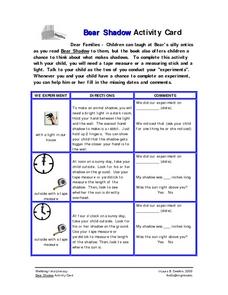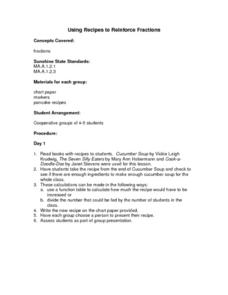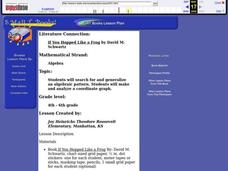Curated OER
"Is a Blue Whale the Biggest Thing There Is?" by Robert Wells
Students discuss how big is big. They compare the area and perimeter of an acre and a football field.
Curated OER
Exploring Area/Perimeter Through Coordinate Geometry
Students explore area and perimeter through coordinate geometry using student literature, hands-on manipulatives, and the Internet.
Curated OER
"Bear Shadow" Activity Card
In this literature and science worksheet, students listen to a family member as they read "Bear Shadow." They conduct experiments that with light, shadows, and measuring tools before recording the date they did the experiment. They...
Curated OER
The Greedy Triangle
Third graders use the book "The Greedy Triangle" to practice measuring perimeter and area. They also calculate the length of objects.
Curated OER
How to Figure Board Feet and Cost of a Board
Students investigate woodworking and converting lengths to cubic measurements. In this math conversions instructional activity, students examine the length of a piece of board, and its total area by using the formula for finding cubic...
Curated OER
Using Recipes To Reinforce Fractions
Students calculate fractions used in various food recipes in this Math lesson with real world applications. The lesson is geared towards upper elementary students but can be adapted for various levels of learners. State math standards...
Curated OER
Piggie Pie!
Students explain about their experiences on the farm and draw pictures to show what they know. Students read the recipe for the piggie pie that Gritch was going to use. Students estimate and then measure how many pigs it would take to...
Curated OER
"Pigs Will Be Pigs" by Amy Axelrod
Students add, subtract, and multiply amounts of money.
Curated OER
"If You Hopped Like a Frog" by David M. Schwartz
Students search for and generalize an algebraic pattern. They make and analyze a coordinate graph.
Curated OER
poem "Smart" by Shel Silverstein from "Where the Sidewalk Ends"
Students incorporate their conceptual understanding of proportions to write a creative piece similar to the example poem.
Curated OER
poem "Smart" by Shel Silverstein from "Where the Sidewalk Ends"
Students explore unit rate and ratio and discuss the relationship.
Curated OER
Measurement, Scale and the Corn Dolly
Students read and discuss the story The Corn Dolly by Terry Jones. The teacher shows the class a corn dolly and they need to design and construct furniture that is appropriately scaled for that specific dolly.
Curated OER
Chemistry Day With Glitter Wands
First graders observe examples of the three states of matter and identify matter in each of the three states. They make glitter wands to remind them of the three states of matter: solid, liquid and gas. Pupils brainstorm and record...
Pyro Innovations
Get into Shape
Shapes are so fun! Little ones explore, identify, and create shapes using tangrams or pattern blocks. The activity is intended to stimulate critical thinking while engaging learners through play and shape identification. Each child will...
Curated OER
The Game is Afoot - A Study of Sherlock Holmes
Mystery is an exciting genre for young readers to investigate. The plots are so intriguing! Here is a series of lessons featuring Sherlock Holmes stories that invite learners to enter the world of the mystery genre. Based on what they...
Curated OER
Weights in Pounds
Second graders define "pound," estimate and compare weights, and classify objects as weighing more or less than a pound.
Curated OER
The Grouchy Ladybug
Students learn about sorting and classifying objects by size while reading Eric Carle's "The Grouchy Ladybug". In this sorting and classifying lesson plan, students first listen to and interact with the story. They then look at cut-outs...
Curated OER
A Look At Rocks
Students write letters to organizations, such as United States Geological Society, to find out more about rocks. Students write about a pretend time they found a magic pebble. Students calculate distances to travel to see various...
Curated OER
I Can Use a Worm to Count
Kindergarteners use worms, puppets or other props to practice counting to 100. First, they listen to a read aloud of Count Worms by Roger Hargeaves. A worm pattern is used to count to 100, with each segment of the worm representing a...
Curated OER
Where Is Japan? How Far Is That?
First graders use literature and hands-on activities with maps and globes to explain distance and tools used to measure distance. They select tools to measure various objects in the classroom, then apply those concepts to their map...
Curated OER
Apples A"Peel" To Me
Second graders study the characteristics and uses for apples through this series of ten lessons. They look at the importance of apples in the US. They read literature about apples, graph, sort, and measure apples, and make apple snacks....
Curated OER
"The King's Chessboard" by David Birch
Students determine how a counting pattern is created is the story. They estimate how much rice is given to the wise man.
Curated OER
"How Many, How Much" by Shel Silverstein
Middle schoolers decide on the reasonableness and relative magnitude of situations in their lives as Shel Silverstein did in the poem "How Many, How Much."

























